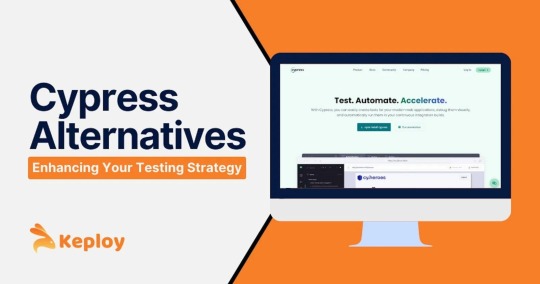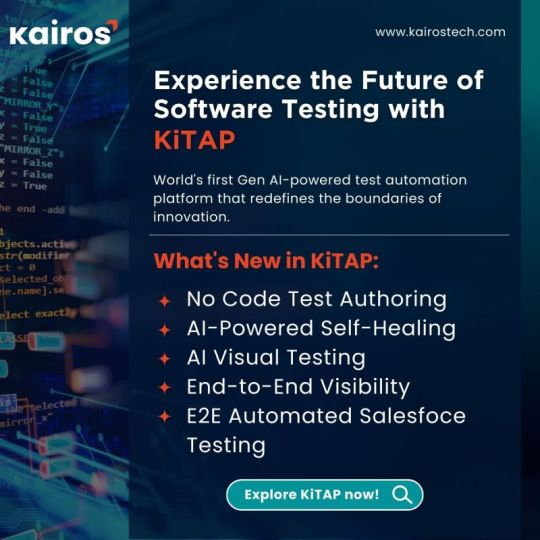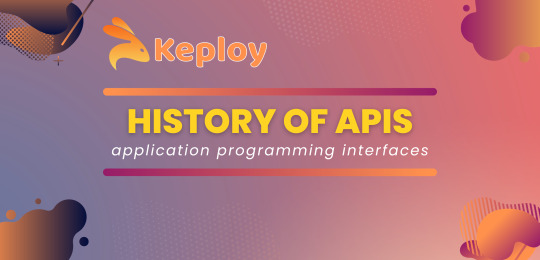#E2E testing
Explore tagged Tumblr posts
Text
Dive into the world of E2E testing! Explore the nuances of Playwright and Cypress frameworks for comprehensive testing solutions.
Choose the right path for seamless end-to-end testing excellence.
0 notes
Text
Top 5 Alternatives to Cypress for Automated Testing

Automated testing has become an integral part of the software development lifecycle, ensuring the reliability and efficiency of applications. Cypress has gained popularity as a powerful end-to-end testing framework, known for its fast execution and real-time browser testing capabilities. However, as with any tool, there are situations where Cypress alternative solutions may better suit the specific needs of a project. In this article, we'll explore some alternatives to Cypress for automated testing.
1. Keploy
Best for automated API testing with efficient test case generation from API calls.
Keploy creates backend API tests with built-in-mocks or stubs by recording your application network calls making your testing process not only faster than unit tests but also incredibly efficient.
Turn API Calls into Test-Cases and Mocks
With Keploy, you can effortlessly record and replay intricate, distributed API flows as mocks and stubs. It's like having a time machine for your tests.
2. Puppeteer
Puppeteer, developed by Google, is a Node.js library that provides a high-level API to control headless browsers or full browsers over the DevTools Protocol. It is commonly used for browser automation, including tasks like taking screenshots, generating PDFs, and scraping data.
Unlike Cypress, Puppeteer does not focus on end-to-end testing but can be utilized for integration testing or scenarios where detailed control over the browser is required. Its integration with the Chrome browser allows for powerful manipulation of web pages.
3. TestCafe
TestCafe is a cross-browser end-to-end testing framework that does not rely on browser plugins. It supports multiple browsers out of the box and allows testing on real devices. TestCafe is known for its ease of setup, as it does not require browser plugins or WebDriver installations.
With a focus on stability and reliability, TestCafe provides automatic waiting for page elements and handles timeouts effectively. It supports various authentication mechanisms and integrates seamlessly with Continuous Integration (CI) tools.
4. Playwright
Developed by Microsoft, Playwright is a Node.js library for browser automation. It supports multiple browsers, including Chrome, Firefox, and WebKit, and provides a simple and concise API for interacting with web pages.
Playwright stands out for its ability to capture screenshots and videos during test execution, making it valuable for debugging and documentation purposes. It also supports cross-browser testing and can be integrated with various testing frameworks.
5. Nightwatch.js
Nightwatch.js is a browser automation framework built on Node.js and Selenium WebDriver. It supports end-to-end testing, allowing developers to write tests in JavaScript or TypeScript. Nightwatch.js provides a clean and concise syntax for writing tests and supports parallel test execution.
One of the advantages of Nightwatch.js is its built-in test runner and assertion library, simplifying the test creation process. It also integrates with popular Continuous Integration tools, making it suitable for automated testing in a CI/CD pipeline.
Conclusion
While Cypress has gained popularity for its speed and simplicity in end-to-end testing, there are various alternatives available, each with its strengths and use cases. The choice of a testing framework depends on the specific requirements of a project, including the need for cross-browser testing, support for different programming languages, and the level of control over browser interactions.
Teams should carefully evaluate their testing requirements, consider factors such as browser support, community support, and integration capabilities, and choose a testing tool that aligns with the goals and complexities of their project. Whether it's Selenium WebDriver, Puppeteer, TestCafe, Playwright, or Nightwatch.js, the right choice will contribute to the effectiveness and efficiency of automated testing in the software development process.
0 notes
Text

MY WIFEEEEEEE
#he’s here !!!!!#WIFE !!!#my malewife 😋#that e2 clara loss was PERSONAL.#mydeimos the undying more like mydeimos testing my patience#its okay i still love him#honkai star rail#hsr#hsr mydei#mydei#mydeimos#tzuu talks
20 notes
·
View notes
Text

22 notes
·
View notes
Text
"Kill yourself" is so overdone. "I hope your favourite operators' operator record consists them talking to a bunch of faceless one-off NPCs instead of any other actual characters" is real. It could happen to you.
#arknights#i wanted more bloopy in glaucus' operator record :(#i'll raise her to e2 60 for more yuribait HG don't test me#quercus' first one is also like this
34 notes
·
View notes
Text
Haven't seen anyone talking about this but at the beginning of the month they kinda shadowdropped a pretty big progression boost for new players with IS3 memory mapping. Because you get four T4 chips and two chip catalysts from each mission reward, and you can access both the IS2 and IS3 monthly squads, you now theoretically have access to enough resources to promote an operator of every class without having to clear the second set of chip stages. It lets you fast-track a few ops, makes those second chip stages much easier, and you only have to make it to the start of floor 3 so you don't even have to fight a boss to get them. Good stuff all around!
#arknights#integrated strategies#new player stuff#I'm actually not 100% sure this works because i can't go back and test it but I do have a friend who's a new player trying it at the moment#Update: it worked! Was a pain but they managed to E2 an operator without the T4 chip stages!
11 notes
·
View notes
Text
very excited for today’s star rail update because this patch has a dan heng il rerun and an aventurine rerun annnndddd actually idk anything else that is happening
#and no more yaoqing trio focus😞#i know absolutely zero about rappa or what this update is about#simply decided it is not my problem#because i NEED dan heng’s e2#if i lose the 50/50 i WILL push all the way to guaranteed do NOT test me#and i really want aventurine’s e1 esp since i failed on it during his last run#but sunday is TEMPTING me like—#ugh decisions#AND all of that means i don’t get to pull acheron😞#awful banner line up i don’t have enough savings for this smh#too many things to pull in star rail and nothing to pull in genshin smh
2 notes
·
View notes
Text
e2 bloopers where jessica steen goes from Ultra Serious Julia to smiling are so fun esp bc it lets me pretend julia ever smiled in her entire life and also she's so cute



looking at the camera does make her seem like she's hosting an educational pbs kinda program educating newcomers about all the fun kinds of poisons you need to avoid on g889 tho
0 notes
Text
Ever since I was young I knew I wanted to increase test coverage.
#in all seriousness if i have to write one more integration test i am going to do something drastic#i am not a qa engineer!#this is not my job!#or it wasn't until i foolishly opened my mouth and expressed a modicum of interest#like an idiot#tech#corporate America#integration testing#sit#e2e#uat#cucumber#playwright#how do I get out of this
0 notes
Text

the sui siblings finally have their own healer woohoo!! (ignore zuo le he's just there for moral support)
#asto speaks#ak#suiposting#ignore the faggot but its just. ignore the teenage boy#not gonna put this in the main tag i'll do that if i ever manage to clear it without zuo le#to be clear he was the last op i picked up and i only e2ed him right before the final bossfight so like#i probably couldve done it without him i just got him cuz i think i was panicking a little in the middle#theres a lot of cn server jokes about zuo le being an unofficial 13th sui sibling anyway so#esp after this event bc shu introduces him to he sheng as her distant cousin (lmao??)#also i hadnt really gotten a chance to test him out yet#hilarious how hes kind of impossible to use inside his own event. maybe im just not doing it right but he keeps dying from the pollution
0 notes
Text

Experience the Future of Software Testing With KiTAP
In the ever-evolving digital realm, KiTAP revolutionizes testing autonomy. Dive into a realm of seamless, automated end-to-end testing, where human intervention becomes a thing of the past.
Escape the shackles of vendor limitations - elevate your testing strategy with KiTAP.
#KairosTech hashtag#FutureReadyKairos hashtag#KLabs hashtag#TestAutomation hashtag#Testing hashtag#Automationtool hashtag#Automation hashtag#QA hashtag#QualityAssurance hashtag#NoCode hashtag#GenAI hashtag#E2E hashtag#SlefHealing hashtag#AIPowered
0 notes
Text
Cypress E2E Testing With React.js: Streamlining Your Testing Workflow Like a JavaScript Ninja
Navigating the intricate landscape of web development, the integration of Cypress E2E testing with React.js stands out as a powerful alliance for enhancing code quality and refining development processes. As React.js becomes the cornerstone for building modern user interfaces, the seamless compatibility with Cypress provides a compelling testing environment. Whether you're considering hiring a React.js developer or engaging a React.js development company, the synergy of these technologies offers a robust solution for end-to-end testing. This blog post will guide you through the setup process, showcasing best practices in writing Cypress tests for React components, addressing asynchronous operations, and seamlessly integrating Cypress into your continuous integration pipeline. By exploring advanced techniques and considerations for hiring React.js developers or collaborating with React.js development companies, you'll unlock the full potential of this dynamic pairing, streamlining your testing workflow and elevating the overall quality of your React.js applications.

Why Cypress? It's More Than Just a Tool, It's a Testing Experience:
Speed Demon: Unlike its sluggish competitors, Cypress runs tests directly within the browser, eliminating the need for separate test runners and shaving precious seconds (or even minutes) off your testing time.
Visualize Your Victory: Forget cryptic logs and confusing errors. Cypress boasts a beautiful, intuitive test runner that displays real-time test execution, screenshots, and detailed logs, making debugging a breeze.
Wait, You Said Automatic? Gone are the days of manually waiting for elements to load. Cypress handles asynchronous operations like a boss, automatically waiting for elements to be visible or actions to complete before proceeding.
Built for the Modern Web: Designed with modern web development in mind, Cypress seamlessly integrates with DevTools, allowing you to leverage your existing debugging skills right within the test runner.
Data-Driven Dynamo: Test different scenarios with ease using data-driven testing, ensuring your application works flawlessly under various conditions.
React.js and Cypress: A Synergy Made in JavaScript Heaven:
Built with JavaScript in Mind: Both React and Cypress share a foundation in JavaScript, making them naturally compatible. Write clear, readable tests that seamlessly interact with your React components.
Component-Level Granularity: Need to test individual React components in isolation? Cypress plays nice with React Testing Library, allowing you to focus on component behavior without relying on implementation details.
Seamless Integration: With tools like Cypress React DevTools, you can easily inspect and interact with your React application state directly from the test runner, streamlining the debugging process.
Streamlining Your Workflow: Tips for the Testing Ninja:
Start Small and Scale Up: Begin by testing key user flows and gradually expand your test coverage as your application evolves.
Organize Your Tests: Use clear naming conventions and group related tests for better maintainability and easier navigation.
Embrace Data-Driven Testing: Define reusable datasets to efficiently test multiple scenarios and edge cases.
Leverage Fixtures: Store common test data or API responses in fixtures to avoid code duplication and simplify test setup.
Record and Replay: Save time and effort by recording user interactions and replaying them as automated tests.
Integrate with CI/CD: Automate your testing pipeline by integrating Cypress with continuous integration and continuous delivery (CI/CD) tools.
Unleash the Testing Ninja Within:
By embracing Cypress and its synergy with React.js, you can transform your E2E testing workflow from a chore into a streamlined, efficient, and even enjoyable experience. So, grab your metaphorical shurikens and mask, channel your inner testing ninja, and start writing tests that would make even the most seasoned developer proud. Remember, with Cypress and React.js on your side, the path to a flawlessly tested application is yours to conquer
Frequently Asked Questions about Cypress E2E Testing with React.js:
General:
What is Cypress E2E testing? Cypress is an end-to-end testing framework specifically designed for modern web applications. It performs real browser actions, making it ideal for testing React.js apps.
Why use Cypress for React.js? Cypress offers several advantages for React testing:
Built for asynchronous apps: Cypress understands React's asynchronous nature, eliminating flaky tests due to timing issues.
Visual diffs for debugging: See exactly what changed after a test failure, making debugging faster and easier.
Developer-friendly API: The API feels natural to React developers, reducing the learning curve.
What are the benefits of using Cypress with React.js?
Reduced costs: Catching bugs early saves time and money on fixing them in production.
Improved quality: Deliver a polished, bug-free app that keeps users happy.
Faster development: Streamlined testing means quicker iterations and faster updates.
Technical:
How do I set up Cypress with React.js? Setting up Cypress is straightforward. You can find detailed instructions in the official documentation: https://docs.cypress.io/guides/overview/why-cypress
What type of tests can I write with Cypress? Cypress supports various test types, including unit, integration, and end-to-end tests.
How do I handle asynchronous actions in my tests? Cypress automatically waits for elements to load before interacting with them, simplifying test writing.
How do I debug failures in Cypress? The intuitive test runner allows you to replay tests step-by-step and pinpoint the exact issue.
Can I integrate Cypress with my CI/CD pipeline? Absolutely! Cypress seamlessly integrates with popular CI/CD tools for automated testing.
Hiring and Expertise:
Do I need to hire a React.js development company for Cypress testing? If you have an in-house development team comfortable with testing and Cypress, you can handle it yourselves. However, hiring a company with expertise in both React and Cypress testing can offer several benefits:
Proven track record and experience: They've built high-quality apps and know how to test them effectively.
Faster adoption and implementation: They can help you set up and integrate Cypress efficiently.
Ongoing support and guidance: They can provide ongoing support and answer your questions as you navigate Cypress testing.
Bonus:
Where can I find more resources on Cypress E2E testing with React.js? The official Cypress documentation is a great starting point: https://docs.cypress.io/guides/overview/why-cypress. Additionally, you can find tutorials, articles, and community forums online.
0 notes
Text
Exploring E2E Testing: Ensuring Software Quality from Start to Finish

In the dynamic landscape of software development, ensuring the quality of applications is paramount. End-to-End (E2E) testing has emerged as a crucial practice to validate that a software application behaves as expected across its entire workflow. This comprehensive testing approach simulates real user scenarios, allowing developers to identify and rectify issues before they reach end-users. In this article, we'll delve into the fundamentals of e2e testing, its benefits, challenges, and best practices.
What is End-to-End Testing?
End-to-End testing is a software testing methodology that evaluates the functionality of an entire application from start to finish. Unlike unit testing, which focuses on individual components, and integration testing, which verifies interactions between components, E2E testing ensures that all components work together seamlessly. This holistic approach mimics the user's experience and validates the application's behavior across different layers and components.
Key Components of E2E Testing:
Automation: E2E testing is often automated to simulate real user interactions. Automated testing frameworks, such as Selenium, Cypress, and TestCafe, enable testers to create scripts that mimic user actions like clicking buttons, filling forms, and navigating through the application.
Scenarios: Test scenarios in E2E testing represent real-world user journeys. These scenarios cover critical paths within the application and help identify potential bottlenecks or issues that users might encounter.
User Interface (UI) Testing: E2E testing extensively covers UI interactions to ensure that the user interface elements and user experience meet the specified requirements. This includes validating layout, design, and responsiveness across various devices and browsers.
Data Flow: E2E testing evaluates the flow of data through the entire system. This involves verifying that data is correctly processed, stored, and retrieved across different components and layers of the application.
Benefits of End-to-End Testing:
Comprehensive Coverage: E2E testing provides a comprehensive examination of the entire application, ensuring that all components work together harmoniously. This helps identify issues that might go unnoticed in unit or integration testing.
Real User Experience: By simulating real user interactions, E2E testing provides insights into how end-users will experience the application. This helps in detecting issues related to usability, performance, and overall user satisfaction.
Early Bug Detection: Identifying and fixing bugs early in the development lifecycle is more cost-effective. E2E testing allows teams to catch issues at an early stage, preventing them from escalating and reaching production.
Increased Confidence in Releases: With thorough E2E testing, development teams gain confidence in the stability and reliability of their applications. This confidence is crucial for frequent and successful software releases.
Challenges in End-to-End Testing:
Complexity and Time: E2E testing can be time-consuming and complex, especially for large and intricate applications. Creating and maintaining a suite of E2E tests requires a significant investment in time and resources.
Flakiness: Automated E2E tests can be susceptible to flakiness, where tests produce inconsistent results due to factors such as network latency, third-party dependencies, or changes in the application's UI.
Maintenance Overhead: As the application evolves, E2E tests may require constant updates to align with changes in the UI, functionality, or underlying architecture. This maintenance overhead can be challenging to manage.
Cost: Developing and maintaining E2E testing infrastructure, including tools and frameworks, can incur costs. Organizations need to balance the benefits of E2E testing with the associated expenses.
Best Practices for Effective E2E Testing:
Selective Test Automation: Not all scenarios need to be automated. Focus on automating critical paths and scenarios that have a high impact on the application's functionality.
Isolation of Test Environments: Ensure that the testing environment is isolated from the production environment to prevent unintended consequences. This includes using separate databases, servers, and configurations.
Regular Test Maintenance: Keep E2E tests up-to-date with changes in the application. Regularly review and update test scripts to align with the evolving features and UI elements.
Parallel Execution: To expedite testing, consider parallel execution of test cases. Running tests concurrently can significantly reduce the overall testing time.
Continuous Integration/Continuous Deployment (CI/CD) Integration: Integrate E2E tests into the CI/CD pipeline to automatically trigger tests with each code change. This ensures that new features are validated and deployed seamlessly.
Collaboration between Teams: Foster collaboration between development, testing, and operations teams to address issues promptly. This collaborative approach enhances communication and accelerates the resolution of identified problems.
Conclusion:
End-to-End testing is a critical element in the software development lifecycle, ensuring that applications meet user expectations and perform seamlessly across various scenarios. While it comes with its challenges, the benefits of comprehensive test coverage, early bug detection, and increased confidence in releases outweigh the drawbacks. By adopting best practices and leveraging automation tools, development teams can harness the power of E2E testing to deliver high-quality software in an efficient and reliable manner.
0 notes
Text
Connecting the Dots: A Comprehensive History of APIs

The term "Application Program Interface" first appeared in a paper called Data structures and techniques for remote computer graphics presented at an AFIPS (American Federation of Information Processing Societies) conference in 1968. It was used to describe the interaction of an application with the rest of the computer system.
In 1974,history of apis was introduced in a paper called The Relational and Network Approaches: Comparison of the Application Programming Interface. APIs then became part of the ANSI/SPARC framework. It's an abstract design standard for DBMS (Database Management Systems) proposed in 1975.
By 1990, the API was defined simply as a set of services available to a programmer for performing certain tasks. As Computer Networks became common in the 1970s and 1980s, programmers wanted to call libraries located not only on their local computers but on computers located elsewhere.
In the 2000s, E-Commerce and information sharing were new and booming. This was when Salesforce, eBay, and Amazon launched their own APIs to expand their impact by making their information more shareable and accessible for the developers.
Salesforce, in 2000, introduced an enterprise-class, web-based automation tool which was the beginning of the SaaS (Software as a Service) revolution.
eBay's APIs in 2000 benefited how goods are sold on the web.
Amazon, in 2002, introduced AWS (Amazon Web Services) which allowed developers to incorporate Amazon's content and features into their own websites. For the first time, e-commerce and data sharing were openly accessible to a wide range of developers.
During this time, the concept of REST (Representational State), a software architectural style, was introduced. The concept was meant to standardize software architecture across the web and help applications easily communicate with each other.
As time passed, APIs helped more and more people connect with each other. Between 2003 and 2006, four major developments happened that changed the way we use the internet.
In 2003, Delicious introduced a service for storing, sharing, and discovering web bookmarks. In 2004, Flickr launched a place to store, organize, and share digital photos online from where developers could easily embed their photos on web pages and social media. These two quickly became popular choices for the emerging social media movement.
In 2006, Facebook launched its API which gave users an unpredictable amount of data from photos and profiles information to friend lists and events. It helped Facebook become the most popular social media platform of that time. Twitter, in the same year, introduced its own API as developers were increasingly scraping data from its site. Facebook and Twitter dominated social media, overtaking the population of which APIs were the backbone. At the same time, Google launched its Google Maps APIs to share the massive amount of geographical data they had collected.
By this time, the world was shifting towards smartphones, people were engaging more and more with their phones and with the online world. These APIs changed the way how people interacted with the internet.
In 2008, Twilio was formed and it was the first company to make API their entire product. They had introduced an API that could communicate via5 phone to make and receive calls or send texts.
In 2010, Instagram launched its photo-sharing app which became popular within a month as social media was booming. Later, as users complained about the lack of Instagram APIs, they introduced their private API.
By this time, developers had also started to think of IoT (Internet of Things), a way to connect our day-to-day devices with the internet. APIs started to reach our cameras, speakers, microphones, watches, and many more day-to-day devices.
In 2014, Amazon launched Alexa as a smart speaker which could play songs, talk to you, make a to-do list, set alarms, stream podcasts, play audiobooks, and provide weather, traffic, sports, and other real-time updates as you command.
In 2017, Fitbit was established which delivered a wide range of wearable devices that could measure our steps count, heart rate, quality of sleep, and various other fitness metrics. It connected our health with the cloud.
As we began connecting increasingly with the internet, privacy and security concerns started to show up. The year 2018 was the year of privacy concerns. People started to think about their data being shared among large organizations without their permission and it could be misused.
An example of users' data being misused could be Facebook's API when one developer discovered that they could use their API to create a quiz that collected personal data from Facebook users and their friend networks and then sold that data to a political consulting firm. This scandal exposed the Dark side of APIs. This made users realize that these APIs aren't free, these large organizations are earning by selling their data with other organizations. In the year 2020, people started to see Web3.0 as a solution to all the privacy concerns as it is based on Blockchain.
As the world is progressing, we are becoming more and more dependent on these APIs to make our lives comfortable. There is still a lot that we are yet to know about the limits of APIs. The future definitely has endless possibilities.
Now that the world has adopted APIs, upcoming is the era of Testing APIs. If you write APIs and are looking for a no-code tool you can check out my open-source project - Keploy.
0 notes
Text

7 notes
·
View notes
Text
bonus! i said i wasn't posting anything new til this weekend but i just got up to s5 e2 and spencer reid with that lollipop has made me insane, here's a drabble i just wrote in like 30 mins. barely edited, hot off the presses, hope u like
sucker
~500 words

Who the hell let this man have a lollipop in the workplace?
You could kill Garcia.
You’re trying to act normal– trying so hard– but he looks so good. His hair is longer than it's ever been, so beautifully curly at the ends and you just know it’s soft. You need to test the theory but you can’t and it kills you on even a regular day.
But today is a thousand times worse. There’s something about Spencer since he got shot, he just seems to give less of a shit. It definitely shouldn’t be as attractive as it is.
It doesn’t help that you’d come in to tell him that you all had to be on the jet in thirty, and then he and Garcia had started asking questions, so Spencer’s been looking up at you from his chair for the past few minutes and something about it is getting to you.
So yeah, you’re trying not to get so immediately caught for staring at Spencer as he wraps his lips around the lollipop again, but you’re also not about to miss a single second of it. You’re not about to do yourself that disservice.
You clear your throat as the news broadcast about your unsub ends. “Right. So we’re going to Louisville.”
Spencer moves to get up, finally. Popping the candy in his mouth, he waves one– large, long-fingered– hand at Garcia and reaches for his crutches.
What is wrong with you?? You need to get it together before you’re stuck on the jet with pretty boy and all of the most astute people-readers in the Western hemisphere.
God, you hate your life. If the universe was kind and loving it wouldn’t have had you meet Spencer in the behavioral analysis unit. If the universe was kind and loving, Spencer would be yours already.
This was some kind of cosmic joke.
“You good?” he asks. He took the lollipop out of his mouth to speak to you, his eyebrows raised in the most annoyingly attractive way.
“Yeah?” you scoff, as if he’s the one being weird.
“Okay. Cause you told me we have to leave and now somehow you can’t keep up with the guy on crutches,” he muses from the doorway, while you haven’t moved an inch.
This man. If he wasn’t injured you would hurt him. You might just do it anyway.
You shoot him a sarcastic smile. “I was being polite.”
“How chivalrous of you,” he says, putting the candy back in his mouth and crutching his way down the hall without a second glance.
You look at Garcia, and it’s a mistake. You can read her like a book. “Don’t,” you warn, pointing at her, and she presses her lips together but is clearly smiling behind them. “And I am so mad at you for that,” you add, gesturing after him.
“Wh– he just took one, it’s not like I–”
“Save it!” you call, already halfway out the room. You hear her laugh behind you, and shake your head. You love that girl, but she was not doing you any favors.
Fuck it.
You breeze past Spencer in the hallway. “Keep up, pretty boy.”
You hear his indignant, playful scoff behind you, and you can’t help the smirk that creeps onto your face.
#im so sorry like i cant be normal about this LOOK AT HIM#good god#spencer reid x reader#spencer reid x you#spencer reid#spencer reid fanfiction#criminal minds#my fics
1K notes
·
View notes